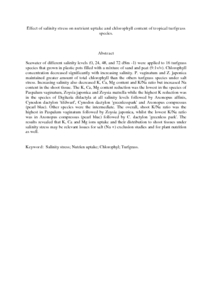Citation
Uddin, Md. Kamal and Juraimi, Abdul Shukor and Ismail , Mohd Razi and Hossain, Md. Alamgir and Othman, Radziah and Abdul Rahim, Anuar
(2011)
Effect of salinity stress on nutrient uptake and chlorophyll content of tropical turfgrass species.
Australian Journal of Crop Science, 5 (6).
pp. 620-629.
ISSN 1835-2693; ESSN:1835-2707
Abstract
Seawater of different salinity levels (0, 24, 48, and 72 dSm -1) were applied to 16 turfgrass species that grown in plastic pots filled with a mixture of sand and peat (9:1v/v). Chlorophyll concentration decreased significantly with increasing salinity. P. vaginatum and Z. japonica maintained greater amount of total chlorophyll than the others turfgrass species under salt stress. Increasing salinity also decreased K, Ca, Mg content and K/Na ratio but increased Na content in the shoot tissue. The K, Ca, Mg content reduction was the lowest in the species of Paspalum vaginatum, Zoysia japonica and Zoysia matrella while the highest K reduction was in the species of Digitaria didactyla at all salinity levels followed by Axonopus affinis, Cynodon dactylon 'tifdwarf', Cynodon dactylon 'greenlesspark' and Axonopus compressus (pearl blue). Other species were the intermediate. The overall, shoot K/Na ratio was the highest in Paspalum vaginatum followed by Zoysia japonica, whilst the lowest K/Na ratio was in Axonopus compressus (pearl blue) followed by C. dactylon 'greenless park'. The results revealed that K, Ca and Mg ions uptake and their distribution to shoot tissues under salinity stress may be relevant issues for salt (Na +) exclusion studies and for plant nutrition as well.
Download File
![[img]](http://psasir.upm.edu.my/24269/1.hassmallThumbnailVersion/Effect%20of%20salinity%20stress%20on%20nutrient%20uptake%20and%20chlorophyll%20content%20of%20tropical%20turfgrass%20species.pdf)  Preview |
|
PDF (Abstract)
Effect of salinity stress on nutrient uptake and chlorophyll content of tropical turfgrass species.pdf
Download (85kB)
| Preview
|
|
Additional Metadata
Actions (login required)
 |
View Item |

